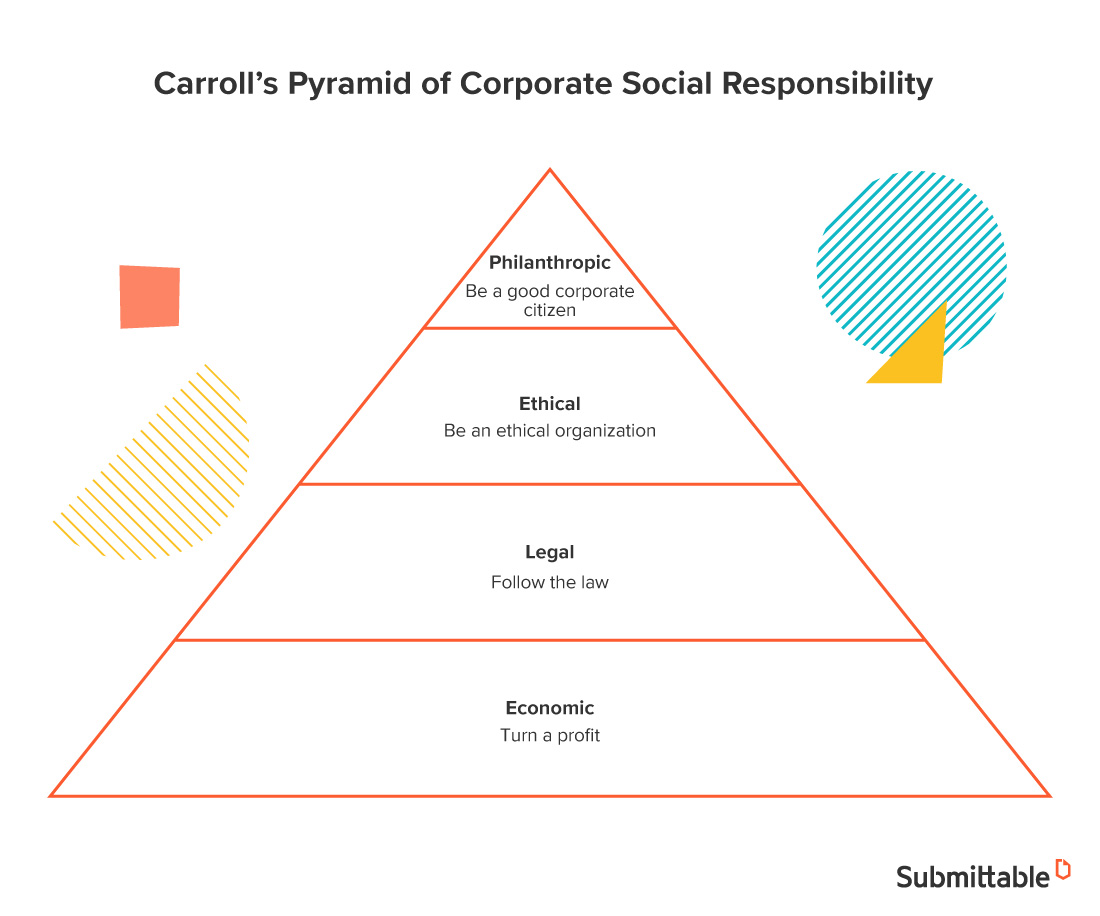Pyramids have gotten a bad rap in the business world—especially when the word “scheme” is involved.
But Archie Carroll’s Pyramid of Corporate Social Responsibility (CSR) might just change your mind about pyramids in the context of corporations.
Because CSR can be complex, messy work that involves legions of internal and external stakeholders often relying heavily on qualitative metrics, frameworks like Carroll’s Pyramid of Corporate Social Responsibility help to simplify a rather nuanced field.
Now that CSR has firmly moved into the C-suite and today’s consumers expect companies to be good corporate citizens, the stakes are higher than ever. Organizational survival is on the line and profits are no longer the singular metric.

Recent research in the journal Management Science found that companies practicing CSR demonstrated higher profit margins, increased valuation, and lower risk. Researchers even discovered that CSR has the tendency to boost product differentiation (meaning consumers leaned towards companies with a solid CSR reputation) as well as deliver a more stable return on assets even amidst economic fluctuations.
Such data confirm Archie Carroll’s framing of how CSR works for modern companies.
It’s multi-faceted.
From the economic to the philanthropic, organizations are expected to demonstrate just how socially responsible they are at all levels. Let’s tackle precisely what those levels are and how they play out for contemporary organizations.

What is Carroll’s Pyramid of Corporate Social Responsibility?
Ask Danielle Holly, CEO of Common Impact, whether frameworks matter in CSR.
As a leader in the field, she’ll likely tell you that they matter a great deal. She’ll probably even show you the measurement framework her team developed to evaluate the impact of skills-based volunteer programs.
While CSR activities can range from outright philanthropic giving and skilled volunteerism to in-kind donations and issue area advocacy, those activities still need to be framed at the outset and measured throughout the CSR campaign.
That’s why frameworks like Carroll’s pyramid are supremely helpful.
As Holly notes, “The best CSR programs take into account a company’s overall strategy, its core competencies and employee talents, and the social impact area that it’s best positioned to address.”
In other words, great CSR campaigns vertically integrated through all levels of an organization’s work—internal and external.
To craft a CSR foundation that will resonate with employees and community stakeholders, Holly says that C-suite and mid-level business leaders must be focused on HR, employee engagement and philanthropy.. It’s a package deal.
Carroll’s Pyramid of Corporate Social Responsibility helps companies think about CSR holistically. If one level is missing or under-resourced, the Great Pyramid of CSR never gets built.
Here’s how organizational leaders can focus on each level while addressing all the layers of CSR.

Organizations should engage on all four levels of Carroll’s pyramid of corporate social responsibility
Southwest Airlines’ triple bottom line (Performance, People, and Planet) approach.
H-E-B grocers’ disaster relief efforts during and after Hurricane Harvey.
Patagonia’s giving its entire $10 million tax cut in 2019 to help mitigate climate change.

Workers at the H-E-B Mobile Kitchen prepare hot meals in Rockport on August 29 for people impacted by Hurricane Harvey.
Photograph by R.G. Ratcliffe
If you’re looking for examples of companies with vertically integrated CSR that are making a big impact, Hannah Nokes has you covered. As the Co-founder of Magnify Impact, she guides companies through a process to “help them determine the strongest foundation for their CSR program.”
For Nokes, it’s pretty simple. Leaders of organizations need to carefully consider what kind of social impact they want to make (“purpose”). That self-reflection needs to align with their organizational capacities (“superpowers”). The end result will be social outcomes (“impact”).
Another very useful framework for CSR.
The companies mentioned above are examples of organizations that have thought and planned long and hard with regard to their purpose and superpowers. Armed with the approach that best suited their brand, they executed up and down Carroll’s Pyramid of CSR.
Here’s a bit more on each level of that pyramid with some helpful business examples.
Get the right tools to support your work
Submittable can help you launch, manage, and measure your CSR program.
Economic responsibilities
At the most basic level, organizations need to create profit through growth. Without succeeding here, there’s no business to do any CSR work.
If a company has any interest in supporting society over the long term, it must meet these core economic responsibilities to its shareholders and stakeholders.
For example, companies that change their approach to packaging materials with a move towards more eco-friendly packaging that is lower in cost than traditional materials would be fulfilling its economic obligation while also meeting environmental obligations.
Legal responsibilities
Organizations must comply with laws and regulations.
These rules are set by governments as part of the social contract. It’s that simple.
It’s important to remember that governments create the markets in which companies exist. Through taxes, fines, and legal interventions of all sorts, citizens empower their leaders to govern the context in which companies conduct their business.
The easy example here is the regulation of our environment.
We have legal frameworks to defend basic human rights to clean air and water because we need those things to survive. Organizations can create and sell their products and services in ways that affect the environment—but only to a point as designated by the government.
When those negative business consequences become too much, companies could face legal proceedings and other levies that set them back financially and threaten their existence. It’s a delicate balance.
Ethical responsibilities
This level of Carroll’s pyramid is all about societal expectations.
Admittedly, those can be opaque. In other words, from company to company, your mileage may vary.
It’s up to management to make those moral decisions that will impact the business, consumers, employees, and the environment. This is where the idea of reputation looms large. Word of mouth and consumer perception has a huge impact on a company’s bottom line.
This is by far the hardest metric that business leaders have to track and manage. It’s also one of the most important.
For example, when employees speak out against internal company practices, companies are often well within their economic and legal “rights” to fire that employee. But should they?
In moments like these, organizational leaders are making difficult cost-benefit calculations. They’re weighing external perception against potential damage that could be inflicted on the company’s economic reality if they choose a different path.
Ethical considerations are rarely easy and they cut to the core of an organization’s values.
Philanthropic responsibilities
These days, businesses are expected to give back.
Generous contributions from companies back to the communities that support them are the baseline nowadays. Modern consumers are hip to the idea that organizations are interconnected with the people and neighborhoods where they do business.
Put succinctly by Senator Elizabeth Warren, everyday citizens just expect well-heeled companies to pay their fair share. Whether it’s corporate taxes or oversized checks handed to deserving students onstage, people have an innate sense that companies should pony up.
One of the most shining examples of corporate philanthropy is Bill Gates. The billionaire who is now getting credit for being ahead of the curve on the threat posed by global pandemics has built a juggernaut philanthropic operation in the form of the Bill and Melinda Gates Foundation.
From education reform to seeding advancements in agricultural technology, his billions have gone a long way towards key CSR goals.
Integrating the pyramid of corporate social responsibility into your CSR management platform
Just like all pyramids, even Archie Carroll’s has its dull edges.
Some researchers have noted that Carroll’s Pyramid of Corporate Social Responsibility fails to tackle conflicting obligations that companies often face and the ethical contours of those decisions. Critics have also noted that culture plays a huge role in organizational decision-making and that Carroll’s model fails to meaningfully take this into account.
This might limit how the framework can be applied across cultural contexts. And what happens when companies don’t do what they promise when it comes to CSR? Even the best theoretical models have a hard time accounting for deception.
While it’s important to note the weaknesses of the model, organizations can still benefit from integrating Carroll’s Pyramid of CSR into their broader social impact strategy. One helpful step in that direction would be managing all CSR work from all-in-one CSR software. This allows companies to measure KPIs at various levels of the pyramid and track progress towards overarching CSR goals.
With all of your CSR work being coordinated in one place, corporate managers of CSR can embrace the holistic approach to achieving social change, and start both growing and giving back.
